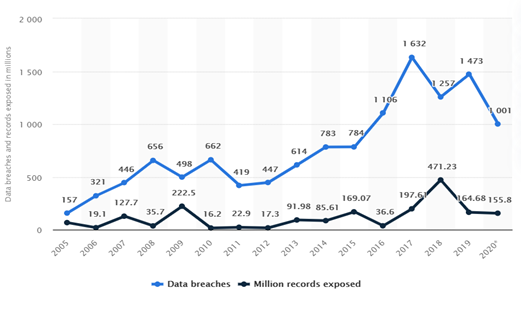Digital civilization to the test of cybercrime threat
In 2020, the serious cyber-attacks recorded were 1.875: a record. For each dollar spent in security, 7 were lost because of “cyber damages”.
Digital acceleration is exposing companies, administrations, and privates to risks. In 2024, losses of 20-25 billion euros are expected in Italy. The expertise guaranteed by the professional loss adjusters of Schwegler Associated will be more and more essentials in the future.
Thanks to the gradual application of the industrial and commercial research in the field of Information and communication technology – with its innovative solutions enabled by infrastructures as cloud computing and 5th generation services – the internet connection will have a bigger distribution in every aspect of everyday life.
Internet of Things, for example, will include 24 billion connected devices all around the world before 2030: an extensive field of attack for criminals of the “cyber universe”. Common users’ safety represents the main challenge of the “digital civilization” (as it was defined by the latest Clusit Report).
The problem seems obvious considering that in 2020 for each dollar invested in cyber defense around the world, cybercrime attacks caused a loss of 7 dollars. A debacle of 945 billion dollars at global level, facing a cost of 145 billion in ICT safety systems. Italian expenses count as for 1% out of total, with a national GDP representing the 1,7% of the global one. Moreover, while the lockdown speeded up the digital pressure, the number of serious cyberattacks registered in 2020 around the world reached the record number of 1.871, 12% more than 2019 and 66% more than 2017.

At this rate, economical losses, in Italy, could reach the number of 20-25 billion euros in 2024, according to the scenario forecasted by the Clusit Report in 2021. Therefore, the support of experts – like the loss adjusters who are part of Schwegler Associated team – will be more and more important in the future: professionals who can evaluate the damages caused by hackers’ attacks or by the leak of confidential documents to organizations or singular citizens.
A need that is already real: aided by the diffusion of smart working, the use of domestic connections and personal devices, 40% of companies reported an increase in cyber attacks in 2020, according to the Observatory of Cybersecurity of the Politecnico of Milan.
It was recently in the news the attack to the system that delivers the electronic register of 40% of Italians schools. Coming back after Easter holidays, professors could not log into the program to upload homework, lessons, documents and notes, a crucial service for distance learning. Hackers hold hostage the platform with a ransomware, requesting bitcoins.
Moreover, the economic slowdown reduced the investments in security in Italy: 2020 spending was 1,37 billion euros, +4% compared to 2019, when the growth had been bigger (+11%). Italy spends 0,07% of the GDP in cybersecurity: 4-5 times less than more advanced countries.
Yet, according to an old saying “nobody was hacked, until he realized it”. The risk is real for everyone, including a giant as Yahoo, hit by on of the biggest data thefts ever revealed, in 2016. Three years before, hackers stole users’ information from about a billion accounts. But it took one year of investigations to fully understand the impact of the raid, which apparently compromised 3 billion accounts.

At this rate, economical losses, in Italy, could reach the number of 20-25 billion euros in 2024, according to the scenario forecasted by the Clusit Report in 2021. Therefore, the support of experts – like the loss adjusters who are part of Schwegler Associated team – will be more and more important in the future: professionals who can evaluate the damages caused by hackers’ attacks or by the leak of confidential documents to organizations or singular citizens.
A need that is already real: aided by the diffusion of smart working, the use of domestic connections and personal devices, 40% of companies reported an increase in cyber attacks in 2020, according to the Observatory of Cybersecurity of the Politecnico of Milan.
It was recently in the news the attack to the system that delivers the electronic register of 40% of Italians schools. Coming back after Easter holidays, professors could not log into the program to upload homework, lessons, documents and notes, a crucial service for distance learning. Hackers hold hostage the platform with a ransomware, requesting bitcoins.
Moreover, the economic slowdown reduced the investments in security in Italy: 2020 spending was 1,37 billion euros, +4% compared to 2019, when the growth had been bigger (+11%). Italy spends 0,07% of the GDP in cybersecurity: 4-5 times less than more advanced countries.
Yet, according to an old saying “nobody was hacked, until he realized it”. The risk is real for everyone, including a giant as Yahoo, hit by on of the biggest data thefts ever revealed, in 2016. Three years before, hackers stole users’ information from about a billion accounts. But it took one year of investigations to fully understand the impact of the raid, which apparently compromised 3 billion accounts.
Danger does not limit the attacks, which increased tenfold in about ten years: from 157 violations in 2005, to the record of 1.632 in 2016 in the US. Last year, 155,8 million people were subjected to the exposure of sensitive data because of a lack in the informatic security or of a human error, according to Statista.
The healthcare and the commercial sector were particularly exposed to cyber-attacks in 2020, with an effect on costs of 133 thousand dollars on average for companies up to 1000 employees and of 500 thousand dollars for bigger businesses. Entities and dimensions that cannot just be limited to a “benchmark” country as the US.
Professional figures with cross competences, able to intervene with accuracy and promptness, like the loss adjusters who are part of Schwegler Associated team, will be more and more requested in the field of cybersecurity, to assure the continuity of the operations and the refund of the damages.
The so-called “ICT use tax”, at a global level the cyber threat hit indiscriminately the governmental sector, the military, police and intelligence sector (14%), healthcare (12%), research and instruction (11%), online services (10%), and multiple targets (20%). There is also an increase in attacks aimed at the financial and bank sectors (8%), ICT producers (5%) and critical infrastructures (4%).
Sources:
- Annual number of data breaches and exposed records in the United States from 2005 to 2020, Statista, 3 marzo 2021
- Clusit: attacchi informatici in crescita, i danni globali valgono due volte il PIL italiano, comunicato stampa Clusit, 2 marzo 2021
- Rapporto Clusit 2021 sulla sicurezza Ict in Italia, Clusit, 16 marzo 2021
- The hidden costs of cybercrime, McAfee report, 7 dicembre 2020
- Cybersecurity in Italia: mercato da 1,37 miliardi e attacchi cyber in crescita, Osservatorio Cybersecurity & Data protection Politecnico Milano, 22 gennaio 2021
- Scuola, il registro elettronico Axios sotto attacco hacker: chiesto un riscatto in bitcoin, Corriere della Sera, 7 aprile 2021
BLOG





